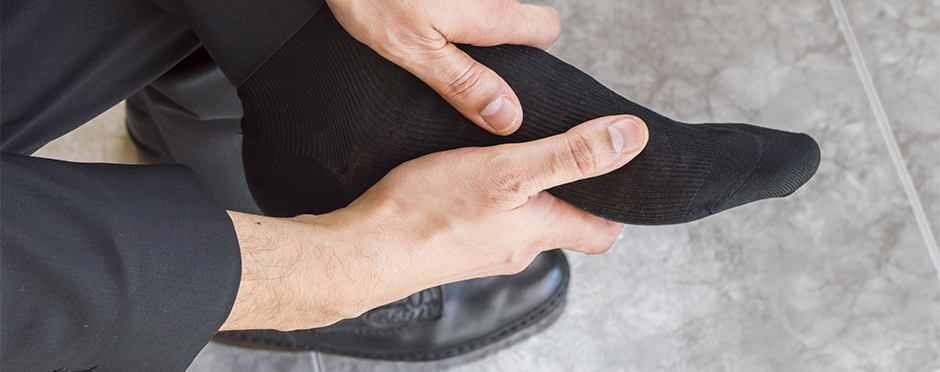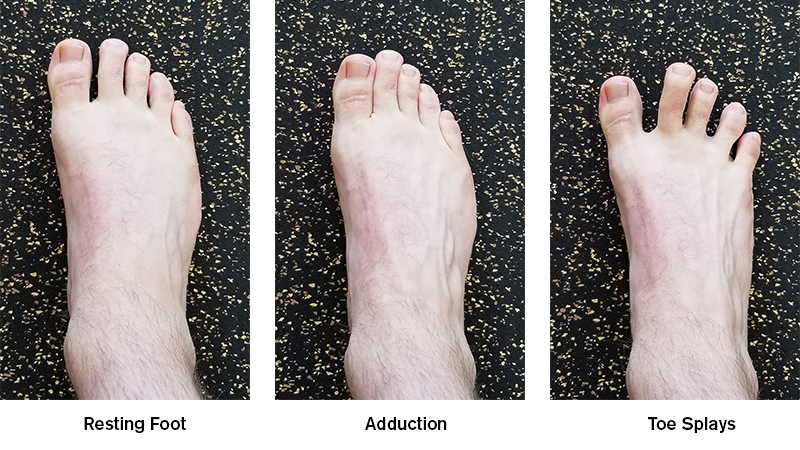
Take Control of Your Feet
5 CommentsThe human body is an incredibly efficient machine that, over time, will adapt to loads and stresses by increasing the strength of its tissues. Walk around any weight room in America and you will see examples of tissue adaptation (think Arnold Schwarzenegger). Conversely, if there is a lack of stress or demand placed on muscle or bone, tissue wasting can occur. A perfect example may be right underneath you: your feet. Imagine someone that sits at a desk while wearing dress shoes for eight hours a day, year-after-year. One evening, he goes for a walk but limps the final steps to his house as his feet have become painful. Some will say this is due to bad arch supports, worn out shoes, or even bad feet. Or, could it be that the muscles in his feet are weak?
The Makings of Your Feet
It has been suggested that the small, intrinsic foot muscles act as trusses, or support beams, for the arches of your feet.¹ Unlike rigid trusses, the arches in your feet have the ability to change and deform based on environmental feedback, like with stepping on a pebble. McKeon and colleagues wrote that “(the foot) also possesses spring-like characteristics, storing and releasing elastic energy with each foot-strike. This is accomplished through the deformation of the arch, which is controlled by intrinsic and extrinsic foot muscles. There is evolutionary evidence that the foot arch architecture and musculature developed in response to the increased demands of load carriage and running.”²
Shoe Contributions
Arch supports and stiffened soles are common in running shoes, and may lead to weaker foot muscles and reduced arch strength as these foot muscles are asked to do less with the external supports that the shoe provides.³,⁴ This weakness contributes to an inability to control deformation of the arch and places greater stress on the plantar fascia, which could possibly lead to plantar fasciitis, a condition that may cause intense heel pain.³ When the arch deforms, it’s essentially acting as a spring. The less control your foot has manipulating this spring, the greater chance for injury. Humans have run barefoot or with minimal footwear for millions of years, with the running shoe only recently becoming a primary accessory.⁵ Amazingly, there is evidence that foot length can be reduced via the raising of the arch after four months of barefoot walking and running.⁶ As Barefoot Ted proclaimed in Born to Run: “No wonder your feet are so sensitive. They’re self-correcting devices. Covering your feet with cushioned shoes is like turning off your smoke alarms.”⁷
Motor Control
Did you know that your feet have dexterity? Virtually any motion you can perform with your fingers, excluding your thumb, your toes should be able to replicate. Bo Jackson, one of the greatest athletes to ever live, can shoot a bow and arrow with his feet! This task may seem impossible to you, but this is likely due to lack of motor control, or the ability to perform movements in a desired manner. Let’s start off with a quick assessment. Try moving your big toe to the side (as shown in the videos below). If able to perform correctly, this contracts a muscle on the medial aspect of your foot called the abductor hallucis, a major contributor to the medial longitudinal arch. If you cannot perform this motion, you are lacking motor control and do not own the fullest potential of your foot.
If the goal is to strengthen a muscle, we must first have the conscious ability to activate that muscle (i.e. motor control). This takes time, and I encourage you to be patient as this will likely take several weeks. Other motions to practice in order to gain mastery over your feet include squeezing your toes together (adduction), raising the medial longitudinal arch by pressing the middle of your big toe into the ground (Janda short foot exercise, see video below), and spreading all of your toes away from each other (toe splays).
(Janda short foot exercise)

Take Control of Your Feet
A long-term solution to myofascial foot pain due to overused or weak muscles may be to retrain and increase their endurance, then allowing them to tolerate the stresses placed on them during upright activities⁸. But, first, adequate motor control is essential. Try spending an hour a day barefoot. You might be surprised at how your feet will change over time. Improved performance and decreased risk for injury are both potential benefits. This article is not an endorsement to discontinue use of arch supports as this is a conversation that should be had with a physical therapist. Rather, an incentive for the general public to take back control of their feet.
If you would like to learn more from an Athletico physical therapist, please use the button below to request an appointment.
The Athletico blog is an educational resource written by Athletico employees. Athletico bloggers are licensed professionals who abide by the code of ethics outlined by their respective professional associations. The content published in blog posts represents the opinion of the individual author based on their expertise and experience. The content provided in this blog is for informational purposes only, does not constitute medical advice and should not be relied on for making personal health decisions.
References:
¹Reeser L, Susman R, Stern J: Electromyographic studies of the human foot:
experimental approaches to hominid evolution. Foot Ankle 1983;3:391–407.
²McKeon P, Hertel J, Bramble D, Davis I. The foot core system: a new paradigm for understanding intrinsic foot muscle function. Brit J Sport Med 2015;49:277-277. Published Online First: 17 Feb 2015.
³Lieberman DE, Venkadesan M, Werbel WA, Daoud AI, D’Andrea S,Davis IS, et al. Foot strike patterns and collision forces in habitually barefoot versus shod runners. Nature 2010;463:531e5.
⁴Nigg B. Biomechanical considerations on barefoot movement and barefoot
shoe concepts. Footwear Sci 2009;1:73e9.
⁵Bramble DM, Lieberman DE. Endurance running and the evolution of
Homo. Nature 2004;432:345e52.
⁶Robbins SE, Hanna AM. Running-related injury prevention through barefoot adaptations. Med Sci Sports Exerc 1987;19:148–56.
⁷McDougall, C. Born to Run: A Hidden Tribe, Superathletes, and the Greatest Race the World Has Never Seen. Knopf. p. 157.
⁸Jam, Bahram. Evaluation and Retraining of the Intrinsic Foot Muscles for Pain Syndromes
Related to Abnormal Control of Pronation. Advanced Physical Therapy Education Institute (APTEI). 2004.

5 Comments
Ryan Barragree
👍good info Jeffrey!
Elene
What a very well-written, amazing and informative article!! It certainly reminds me of the issues I have with my feet and the reasons for my pain and discomfort.
Colette Bernica
Well written and a topic I knew nothing about. I have bad feet and have been told to never go barefoot but I do anyhow.
Tyson H
Great article. Instantly had a foot cramp when trying to move my big toes. Really going to focus on these tips.
Thanks!
Tina
@Colette I was told by my general physician that I may never walk barefoot again and she recommended me all sorts of shoe inserts and supports. Instead I chose to walk barefoot at home, bought toe separators, and started doing foot exercises. My feet have never felt better!